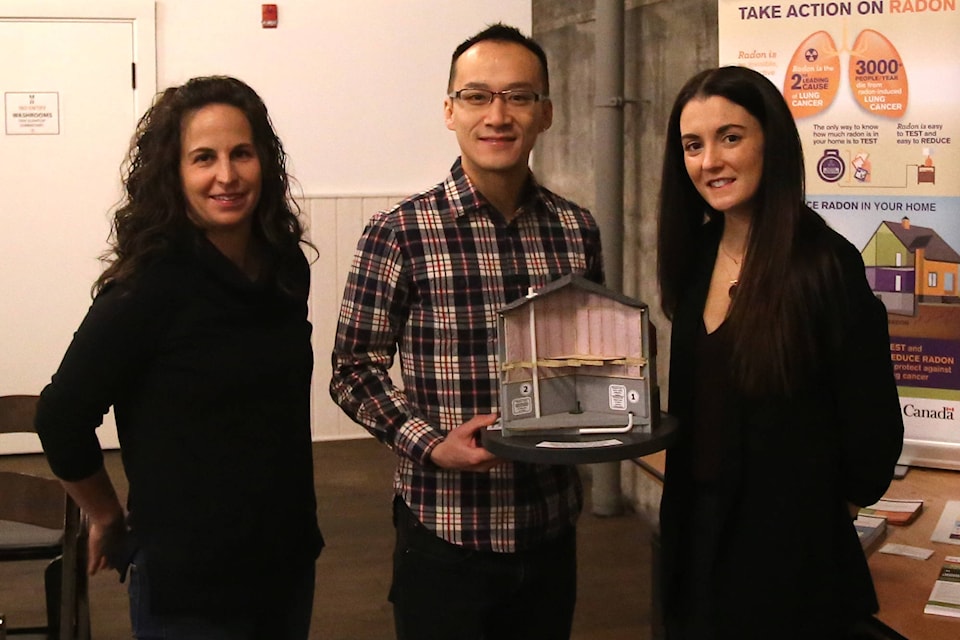Did you know that there could be a lung-cancer-causing, colourless, odourless gas in your home?
Radon is the byproduct of decomposing uranium in the soil. Because it does not chemically react with anything it moves easily through the soil and through cracks in the foundation of your home, where it can build up.
“Where the issue rises is when it accumulates,” said Lindsay Forsman-Phillips, project manager for CAREX Canada.
Though there aren’t immediate effects, radon is known to cause lung cancer in the long term.
“In Canada, it is the leading cause of lung cancer for non-smokers,” said Micky Leung, our regional radiation specialist with Health Canada.
It accounts for around 16 per cent of lung cancers which is around 3,200 deaths a year, or 8 per day, Leung explained.
| Gary Sulz did the radon take-home test and found his home had extremely high levels. (File photo) |
For Revelstoke resident Gary Sulz, this information was enough for him to pick up the testing kit, which is basically a canister with a piece of bullet-proof plastic inside.
“The radiation from the radon damages that plastic,” said Chantal Wilson, of Revelstoke’s Little Bear Engineering. “It will create little scratches and pit marks in it from when the radiation hits it.”
Sulz set up the testing kit in his home and three months later sent it in for analyses.
He said it seemed to take forever to get the results, but when they came in he got an email and a phone call on the same day.
Health Canada recommends taking remedial action if the radon measurements in your building are higher than 200 Becquerels per metre cubed. In Sulz’s home the readings were above 4,500.
“My grand children play in my home and live and stay downstairs when they come to visit, so for me it was very important that our basement was finished and we needed to make sure that anyone who came into our home was safe,” he said.
Sulz hired Wilson to identify how to decrease the radon levels in his home. They ended up installing two separate systems, as the building is on two separate slabs.
Now his radon readings are between 30 on a rainy day and 19 on a hot, dry day.
However, even though Health Canada’s guideline is 200, Leung said the lower the better.
“We just want to be exposed to radon gas as low as possible,” he said. “Even though Health Canada says 200, it’s not a safe level, it’s just a level to recommend action for mitigation.”
For the most part radon comes up through the ground and into your home. Though people above the ground floor aren’t completely safe, Forsman-Phillips said that homes in Nunavut, which are built above the ground, don’t often have high levels of radon because it is able to dissipate.
Depending on how much uranium is in the soil, different areas have a higher or lower risk of radon.
“I am seeing in Revelstoke about 38 per cent of the homes are over the Health Canada guideline amount,” said Wilson. “We can get some extremely high levels here.”
However, the levels can vary from home to home. If you do the test and the results are high, Wilson and Little Bear Engineering can help. Wilson said she will go into your home to do an assessment at no charge and make recommendations on how best to lower radon levels.
Sometimes it is as simple as sealing a crack in your slab or opening the basement door, however other times it isn’t as easy.
“If you are in the higher levels then the active subslab depressurization system is the best option,” she said.
Those systems run between $2-3,000.
Since reducing the radon levels in his home Sulz has become an advocate of sorts, encouraging people to do the at-home test. He said he has seen a lot of cancer incidents through his career in funeral services and hopes to see less.
“If there are ways that we can mitigate this kind of stuff then why don’t we do it?” he said.
For more information visit healthcanada.gc.ca/radon or call reach our regional radon specialist at 604-666-3351 or by email at radon_bcyt@hc-sc.gc.ca
@JDoll_Revy
jocelyn.doll@revelstokereview.com
Like us on Facebook and follow us on Twitter.
